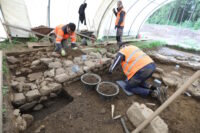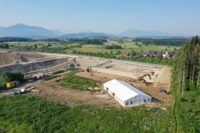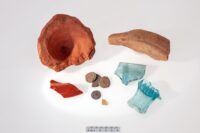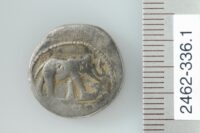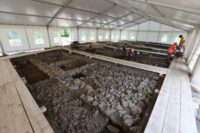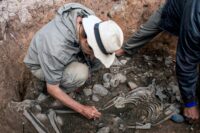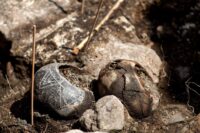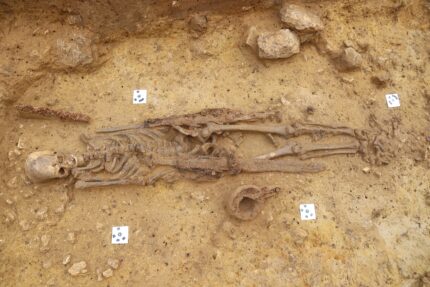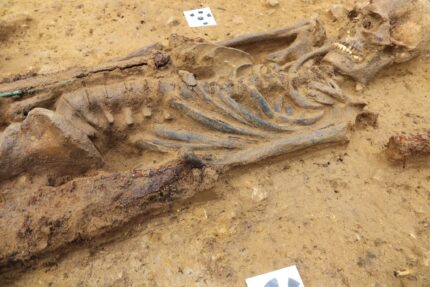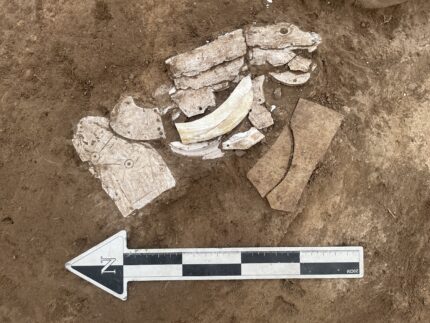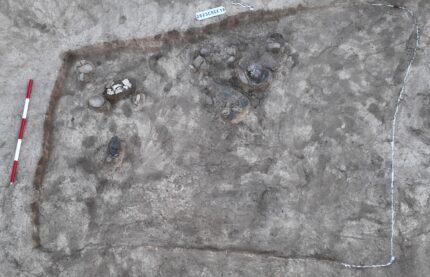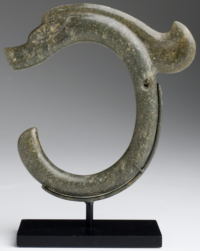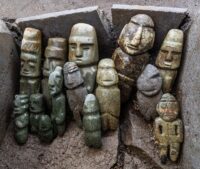 A stone offering box containing a ritual deposit of 15 anthropomorphic figurines has been unearthed at the Templo Mayor of Tenochtitlan in Mexico City. It was found under the platform of the rear façade of the temple in a layer that dates to the reign of Aztec emperor and king of Tenochtitlan Moctezuma I (1440-1469 A.D.),
A stone offering box containing a ritual deposit of 15 anthropomorphic figurines has been unearthed at the Templo Mayor of Tenochtitlan in Mexico City. It was found under the platform of the rear façade of the temple in a layer that dates to the reign of Aztec emperor and king of Tenochtitlan Moctezuma I (1440-1469 A.D.),
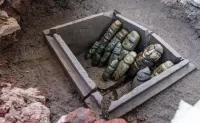 The anthropomorphic figures are sculpted in the style typical of the Mezcala culture who inhabited what is now the northern Guerrero state of southwestern Mexico between the Preclassic (700-200 B.C.) and Classic (250-650 A.D.) periods. The Mezcala style is distinguished by an abstract, geometric design even in the facial features of its anthropomorphic figures.
The anthropomorphic figures are sculpted in the style typical of the Mezcala culture who inhabited what is now the northern Guerrero state of southwestern Mexico between the Preclassic (700-200 B.C.) and Classic (250-650 A.D.) periods. The Mezcala style is distinguished by an abstract, geometric design even in the facial features of its anthropomorphic figures.
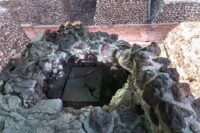 The Mexica conquered the area in the mid-15th century when Moctezuma I significantly expanded the Aztec empire. The Mezcala culture was long gone by then, but the Mexica prized their artifacts, going so far as to excavate ancient sites seeking out Mezcala sculptures. Several offering groupings of Mezcala figurines, some more than 1,000 years old by the time the Aztecs pillaged them, have been found at the Templo Mayor of Tenochtitlan with more than two dozen of the anthropomorphic sculptures carefully placed in rows facing south inside two stone boxes.
The Mexica conquered the area in the mid-15th century when Moctezuma I significantly expanded the Aztec empire. The Mezcala culture was long gone by then, but the Mexica prized their artifacts, going so far as to excavate ancient sites seeking out Mezcala sculptures. Several offering groupings of Mezcala figurines, some more than 1,000 years old by the time the Aztecs pillaged them, have been found at the Templo Mayor of Tenochtitlan with more than two dozen of the anthropomorphic sculptures carefully placed in rows facing south inside two stone boxes.
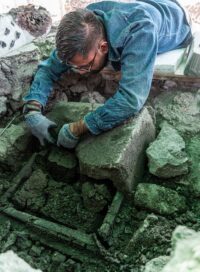 The most recent discovery of figurines was contained in a quadrangular stone chest that was meticulously excavated between January and July of this year. Dubbed Offering 186, the box contained 14 male anthropomorphic figurines and one miniature female figurine. Carved from green metamorphic stones, the largest figurine is just shy of a foot high, while the smallest miniature is just one inch high. The remains of facial paint representing the Mexica god of rain, Tlaloc, were found on one of the figurines. Archaeologists believe this was part of a deliberate reset of religious signification by the Mexica of the ancient cult figurines.
The most recent discovery of figurines was contained in a quadrangular stone chest that was meticulously excavated between January and July of this year. Dubbed Offering 186, the box contained 14 male anthropomorphic figurines and one miniature female figurine. Carved from green metamorphic stones, the largest figurine is just shy of a foot high, while the smallest miniature is just one inch high. The remains of facial paint representing the Mexica god of rain, Tlaloc, were found on one of the figurines. Archaeologists believe this was part of a deliberate reset of religious signification by the Mexica of the ancient cult figurines.
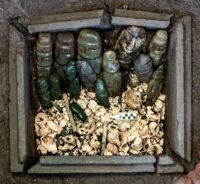 The box also contained two rattlesnake design earrings, 135 greenstone beads, sea sand and 1,942 seashells, snail shells and coral. The sand and shells came from the Atlantic shore, an area conquered by the Aztecs of the Triple Alliance (the combined forces of three Mexica city-states, Tenochtitlan, Tetzcoco, and Tlacopan) under Moctezuma I.
The box also contained two rattlesnake design earrings, 135 greenstone beads, sea sand and 1,942 seashells, snail shells and coral. The sand and shells came from the Atlantic shore, an area conquered by the Aztecs of the Triple Alliance (the combined forces of three Mexica city-states, Tenochtitlan, Tetzcoco, and Tlacopan) under Moctezuma I.
“In classical Nahuatl, these chests were known as tepetlacalli –from tetl , stone, and petlacalli, reed box. In their homes, the Mexicas used to keep their most precious belongings in reed chests, such as fine feathers, jewelry or cotton garments, and if we see it from the Templo Mayor, which represents a sacred mountain full of maintenance, we can imagine the priests storing in these ‘stone flasks’ the quintessential symbols of water and fertility: sculptures of the rain gods, green stone beads, shells and snails”, concludes López Luján.
